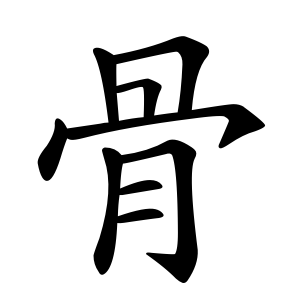骨
- bone;
Etymology
It is a compound ideograph formed by combining:
肉 (육) – representing flesh,
冎 (과) – a pictograph showing the skull and upper bones like the spine or shoulder blades.
The 冎 component is said to resemble the skull, neck bones, and shoulder bones of a cow, and the full character expresses “bone within flesh.”
Usage in Korean
As a semantic radical, 骨 appears in characters related to the skeleton, human or animal body, or internal structure.
Examples:
髓 (수) – marrow
體 (체) – body, form
骸 (해) – remains, skeleton
These characters reflect meanings tied to anatomy, structure, and bodily form.
In summary, 骨 not only depicts the shape and function of bones, but also serves as a meaningful radical in many body-related characters.
Alternative forms
骨 - traditional Kangxi form (10 strokes) in Hong Kong, Macau, Japan, Korea, Vietnam;
骨 - traditional modified form (10 strokes) in Taiwan;
骨 - simplified form (9 strokes) in Mainland China.
Characters with 骨
- 月月月 (BBB)
- ⿱⿵⿰ 丨 𠃍 𠃍 肎 (G)
- ⿱⿵⿰ 丨 𠃍 ⿰丨 一 肎 (H T J K V)
